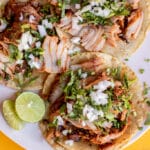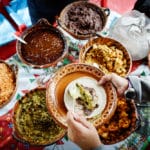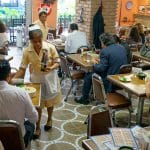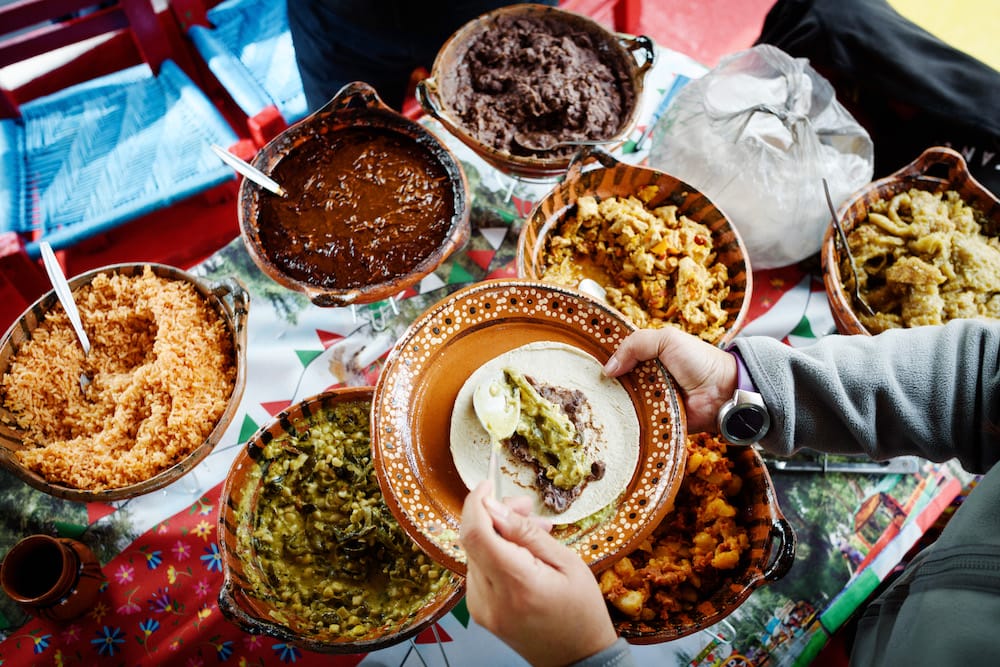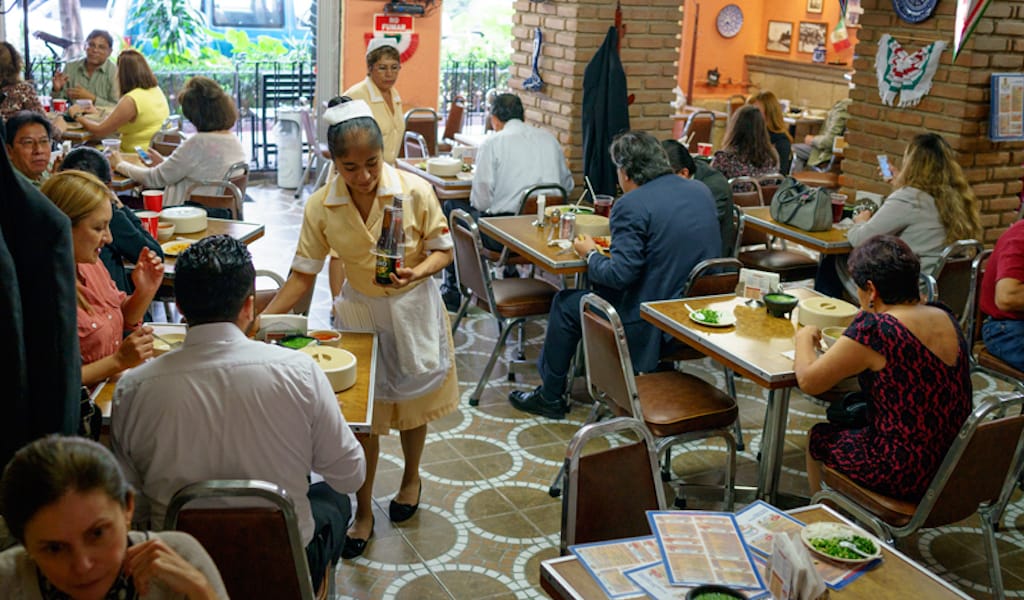In the heart of CDMX’s Colonia Escandón, near the corner of Avenida Patriotismo and Calle José Martí, customers hover about, looking for a spot to sit or stand at El Rincón Tarasco. They’ve come here in search of carnitas tacos, which this family-owned restaurant has been serving in the authentic Michoacán style – tender, juicy pork meat with a crispy brown finish, giving it a kind of special sweetness – for over 40 years.
Waiting for our tacos, we talked with Claudia Zapien about the origins of her family’s taqueria. “We come from a small town in Michoacán called Zacapu. My father, Roberto Zapien, had worked in the meat trade there where it was common to do carnitas, so he started to make them here in his regional style, at this same location, in the year of 1978.” The restaurant’s name comes from the Tarascan culture, also known as Purépecha, the Pre-Hispanic nation settled in Michoacán, an independent nation and rival of the Aztecs.

Preparing and eating tacos de carnitas is one of the most intimate rituals of the Mexican way of life, and the concept of pork meat tacos runs deep in Mexico’s history.
One of the firsts mentions of this ingredient in Mexican gastronomy is narrated by the conqueror Bernal Díaz del Castillo in his book The True History of the Conquest of Mexico (written 1568): “After we had thus subdued the great, the populous, and the celebrated city of Mexico…Cortes ordered a banquet to be prepared in Coyoacán, to celebrate the conquest with a joyous feast, at which the wine which had come with a vessel recently run into Vera Cruz, and the hog’s meat from Cuba, were not spared.”
The most accepted conclusion is that those hogs were eaten with tortillas, thus this event is considered the birth of carnitas tacos.
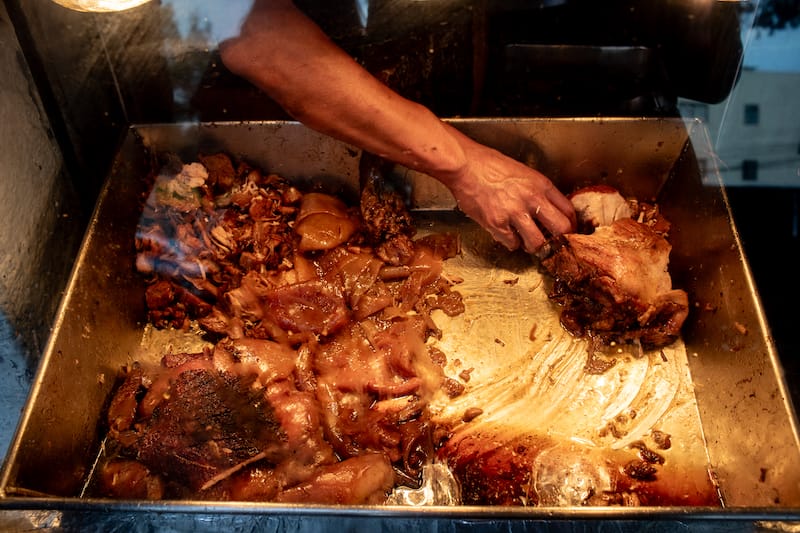
This feast took place more than 500 years ago, and many things have changed in Mexican cooking, but the principle of carnitas has stayed the same: slowly fry the meat in its own lard, a cooking technique known in most of the world as confit. Claudia explains a theory that is common in central Mexico: “Confit was a method of preservation for pork meat that was used by the settlers in the region during the 19th century – Spanish, French or Italian – who also made the huge metal pots that are used for the carnitas.”
As for the recipe, many secrets surround the in the preparation and seasoning of this specialty; differences from the spices used, how the tacos are served, and all the salsas and garnishes. Every carnitas cook will swear that only uses salt for seasoning, but local folklore makes many references to different ingredients that be added to the lard, such as water, juice, soda, fruits, chilies, herbs, caramel, milk…the list goes on, but no one is eager to share their formula.
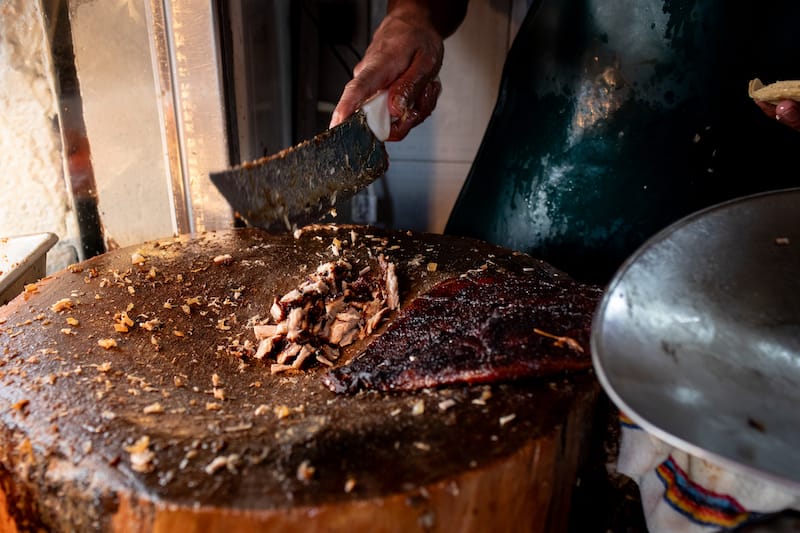
One consistency: the whole pig goes into the carnitas pot, and nothing goes to waste. Every piece has a special name:
Maciza: Lean pork meat from the leg, blade or loin.
Chamorro: Knees or knuckles.
Buche: Stomach.
Nana: Uterus/womb of a female pig.
Cuero or cuerito: The soft skin of the pig.
Chicharrón: Crispy pork rind, also made with the skin, but in a very different process.
Chiquita or chicalada: The small bits of meat that fall to the bottom of the pot and come out deep-fried and crispy. A house specialty at El Rincón Tarasco.
Cuero de panza: Pork belly.
Costilla: Spare ribs, here served bone-in
Other parts maintain their usual names: the liver, kidneys and other viscera, in addition to parts of the head like the ear, the nose, cheek and tongue. The brains, known as sesos, are a remarkable specialty at El Rincón Tarasco: spiced and fried in crispy quesadillas for 13 pesos each.
In the world of carnitas are classic combinations made with different parts; one of the most asked for is maciza with cuerito. Rincón Tarasco has a house mixture whose name, the “Pedro Chavez” is based on a scene from the 1953 film Dos Tipos de Cuidado with Pedro Infante. The taco combines buche with cuero de panza – stomach and pork belly – a treat suited for the real aficionado.
Here tacos are served with two fresh salsas, red or green; both are raw, spicy and simple, made just with tomato or tomatillo, onion, serrano chili and cilantro. There is also a special salsa made with vinegar, onions and chili manzano, a yellow chili that can sometimes be very mild, and sometimes fearsomely hot! This goes back to the traditional way of seasoning tacos in the town of Zacapu, where carnitas are eaten with pickled chiles instead of salsas. There are no other garnishes with which to share the spotlight; at Rincón Tarasco, it’s just carnitas and salsas.

In Mexico City one can find many different versions and styles of carnitas, but it is fair to say that the most common tacos are made on very small tortillas with cilantro and onion on top of the meat, among other characteristics.
“[At the beginning], it was hard for my father to sell his carnitas,” Claudia tells us, “because they were very different [from typical street tacos], with bigger tortillas and no garnish. So he started giving away his tacos for free to people walking by, or he would go to bars and stores in the neighborhood with a basket full of his ‘promotional’ tacos. This is how he started to attract clientele to the taqueria. When people asked why the carnitas where so good, Don Roberto would answer: ‘Because I also cook them for myself!’ He taught us to do all the things well, and we continue his legacy at the same place and with the same commitment for the job, with a lot of respect for the customer.”

The original location on Patriotismo is a small space with two big stainless-steel pots where the carnitas are cooked, a glass counter displaying the different cuts of meat ready to be served, a chopping block, and just one table. An adjoining locale has some extra chairs, a basket of quesadillas, and not much more. By the turn of the century the family opened a second venue just one block away, at Comercio Street #131. This is a formal restaurant that offers almost the same selection, with the addition of handmade tortillas and its celebrated gorditas, which are fried corn masa patties filled with finely chopped “chiquita,” the crispy brown deep fried pork meat, at 36 pesos each.
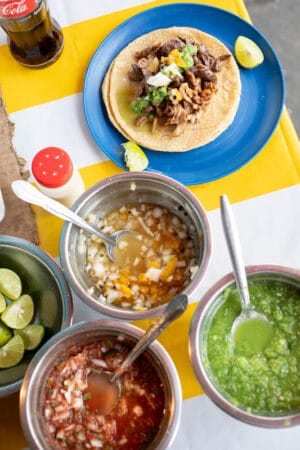
The Zapiens also make mixiotes, a central Mexico specialty that consists of steamed lamb meat that traditionally was cooked inside the outer skin of the agave plant, but has since been substituted with a special paper. The mixiotes come with a big portion of lamb meat spiced with red chili, and tortillas to make your own tacos. At El Rincón, they also make their own handcrafted chorizo, a special product at 140 pesos for one kilo. Cold beer and micheladas are also on hand – very important items.
The Comercio location place has a lot of tables and a large kitchen, where five stainless steel pots very patiently slow-cook the carnitas. There is also a big griddle where the tortillas are handmade and the gorditas prepared, also with fresh masa, before being fried.
Every weekend, El Rincón Tarasco has a line of customers waiting at the door. People come for the quintessential carnitas taqueria, but they stay for the hospitality of the Zapien family – Claudia, Jesus, Roberto, Patricia and her husband Martín – true ambassadors of Tarascan culture. “We want to bring a little bit of our heart, our dreams and efforts, to your palate,” says Claudia.
Alejandro EscalanteAndrew Reiner
Published on August 04, 2023
Related stories
February 21, 2024
Mexico City | By Cristina Alonso
Mexico CitySometimes we like to dress up on Friday nights and head out to a nice cocktail bar. But other times, all we want to do is end a busy week with delicious tacos and good conversation. And that’s exactly what we set out to do when we decided to kick off our weekend with an…
August 26, 2023
MexicoQuick bite: On this full-day tour of Xochimilco, for private groups of seven or more, we will have exclusive access by private boat to family farms, meet the people upholding ancient agricultural traditions and enjoy a rustic feast in a field surrounded by canals and family gardens. The day begins with breakfast, ends with a…
February 23, 2023
Mexico CityIn a town that runs on tacos, tacos de guisado may be the most ubiquitous version of the iconic dish in Mexico City. They can be found almost anywhere in the city, from specialty restaurants to markets, tianguis and street vendors selling them at stalls or even out of the trunk of a car. It…














































